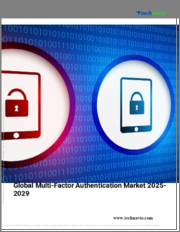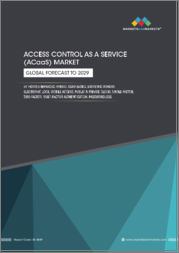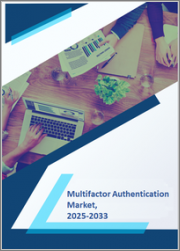
|
시장보고서
상품코드
1851437
세계의 다중 인증(MFA) 시장 : 점유율 분석, 산업 동향, 통계, 성장 예측(2025-2030년)Multifactor Authentication (MFA) - Market Share Analysis, Industry Trends & Statistics, Growth Forecasts (2025 - 2030) |
||||||
세계의 다중 인증(MFA) 시장 규모는 2025년 211억 1,000만 달러로, 2030년에는 453억 달러에 이를 것으로 예측되고 있습니다.

이러한 성장 궤도를 지원하는 것은 제로 트러스트 채택, 데이터 보호 지침 강화, 랜섬웨어 증가 등 강력한 인증에 대한 긴급 투자를 촉진하는 요인입니다. 미국의 2025년 HIPAA 보안 규칙과 유럽의 디지털 ID 지갑 규제와 같은 규제는 기본 OTP 툴에서 피싱에 강한 패스키나 하드웨어 토큰으로 조달이 전환되고 있으며, 다중 인증 시장이 고신뢰성 솔루션으로 이행하고 있는 것을 확인하고 있습니다. 동시에 보안 요소 칩에 대한 공급 체인 충격과 A2P SMS 수수료가 증가하여 구매자를 소프트웨어 기반 또는 장치 내장 요소로 향하게 합니다. 북미 제로 트러스트 리더십, 아시아태평양 모바일 ID 이니셔티브 및 유럽 지갑 규제는 2030년까지 다중 인증 업계의 2자릿수 확대를 유지하는 세계 플라이휠을 생산하고 있습니다.
세계의 다중 인증(MFA) 시장 동향과 통찰
규제 업계 전반에 걸친 제로 신뢰 보안 아키텍처로의 급속한 전환
제로 트러스트 다이어그램에서는 모든 세션에서 지속적인 본인 확인이 필요하며 MFA는 선택 사양의 추가 기능에서 핵심 제어로 승격됩니다. 캐나다 은행은 OSFI B-13에 따라 SMS OTP를 폐지하고 하드웨어 토큰과 생체 인식 요소를 일상 업무에 도입해야 합니다. Capital One을 포함한 미국 금융 선도사는 2025년 말까지 직원의 비밀번호를 제거하고 자격 증명 위험을 줄이는 장치 인증서 앵커 패스키로 대체할 것을 약속했습니다. 벤더는 직원, 고객, 머신의 ID를 통합하는 플랫폼 패브릭을 구축함으로써 이에 대응하고, 다중 인증 시장의 에코시스템의 폭을 넓히고 있습니다.
서비스형 랜섬웨어 급증으로 보험료 인상을 촉진
사이버 보험 회사는 현재 피싱에 강한 MFA를 기본 위생 관리로 취급하고 있습니다. 전자 메일 전용 또는 SMS-OTP가 도입된 경우 보험 계약이 거부되거나 보험료가 인상되므로 MFA에 대한 투자는 직접적인 보험 비용 헤지가 됩니다. 적대적 중간자 키트가 상품화됨에 따라 이사회는 자금을 경계 방화벽에서 정체성 보증으로 옮겨 가고 있으며, 지금까지 근대화가 늦어진 중소기업들 사이에서 다중 요소 인증 시장 수요를 추진하고 있습니다.
레거시 SCADA/ICS 환경의 제한된 MFA 상호 운용성
산업용 네트워크는 결정적인 대기 시간과 지속적인 가동 시간에 의존합니다. 추가 로그인 단계를 삽입하면 다운타임의 위험이 있으므로 플랜트 운영자는 완전한 MFA를 뒷받침하는 것이 아니라 IT에서 OT를 분리하고 중공업에서 도달할 수 있는 다중 요소 인증 시장 수익에 상한선을 두고 있습니다.
부문 분석
소프트웨어 솔루션은 2024년 수익의 48.3%를 창출하여 다중 인증 시장의 가장 큰 슬라이스를 지원합니다. 구독 라이선싱, API 툴킷 및 클라우드 콘솔은 하이브리드 워크포스로의 배포를 간소화합니다. 이 부문의 가치 제안은 기업이 경계 관리를 컴플라이언스 리포팅과 적응 위험 메트릭을 통합 한 아이덴티티 패브릭으로 전환함에 따라 더욱 확대됩니다. WebAuthn 툴체인과 SDK로 대표되는 비밀번호가 없는 플랫폼은 자격 증명 데이터베이스를 지우고 피싱을 근본적으로 격퇴하는 요인에 대한 구매자의 취향을 반영하여 CAGR 19.2%로 성장을 지속하고, 있습니다. 하드웨어는 보안 요소의 격리된 스토리지를 필요로 하는 규제 대상 워크로드에 필수적인 것은 아니지만 칩 부족으로 토큰 비용이 상승하고 예산을 소프트웨어로 유도하고 있습니다.
구현 전문 지식에 대한 수요는 매니지드 서비스를 매력적인 틈새 분야로 바꾸고 있습니다. 서비스 파트너는 등록 캠페인을 설계하고 레거시 앱을 리노베이션하며 MFA 대시보드를 모니터링하여 단일 제품 소개를 정기적인 권고 수익으로 전환합니다. 그 결과 선도적인 통합 업체는 롤아웃을 보다 광범위한 제로 트러스트 프로젝트와 번들하여 평균 계약 금액을 늘리고 다중 인증 시장의 플랫폼 중심 조달로의 전환을 강화했습니다.
2요소 로그인은 주로 신속한 위험 감소를 실현하는 인증 앱과 SMS 코드를 통해 2024년 매출의 46.4%를 여전히 지원하고 있습니다. 그러나 브라우저와 모바일 OS 벤더가 FIDO2를 네이티브 워크플로우에 통합함에 따라 피싱에 강한 패스키가 CAGR 18.4%로 확대되고 있습니다. 새로운 소비자 계정을 기본적으로 비밀번호가 없는 Microsoft의 결정은 강력한 참조 모델을 제공합니다. 3개 이상의 요소를 필요로 하는 다중 요소 프레임워크는 일부 정부기관과 금융 분야에서 여전히 필수적이지만, 보다 광범위한 상업적 의욕은 요소의 강도를 동적으로 상승시키는 위험 기반 오케스트레이션으로 전환합니다.
다중 요소 인증 시장은 제공 유형(하드웨어, 소프트웨어, 서비스), 인증 모델(2요소, 다중 요소, 기타), 배포 모드(On-Premise, 클라우드, 하이브리드), 기업 규모(중소기업, 대기업), 액세스 채널(VPN, 원격 로그인 등), 최종 사용자 업계(은행, 금융 기관 등), 지역별로 구분됩니다. 시장 예측은 금액(달러)으로 제공됩니다.
지역별 분석
북미는 2024년에 37.8%의 매출을 유지했으며, 2030년까지의 CAGR은 14.2%로 예상됩니다. 중요 인프라의 사이버 보안에 관한 미국의 행정 명령과 캐나다의 OSFI B-13이 MFA를 제도화하고, 이 지역에 본사를 둔 신원 SaaS 벤더의 에코시스템이 혁신 사이클을 활발하게 하고 있습니다. 따라서 북미의 다중 인증 시장 규모는 제로 트러스트 조달이 유지 보수 단계에 들어가고 공급업체가 적응 분석을 업셀링함에 따라 꾸준히 확대되고 있습니다.
아시아태평양은 정부의 정체성 프로그램 덕분에 CAGR 16.5%의 궤도를 타고 있습니다. 일본의 마이넘버 스마트폰 자격은 현재 650개 이상의 기업의 로그인을 지원하고 있으며, 싱가포르 은행은 SMS를 FIDO 토큰으로 대체하여 주류 채용을 확대하고 있습니다. 호주 디지털 ID 프레임워크는 연방 정부 서비스에 패스키를 전개하고 민간 부문의 모방에 박차를 가하고 있습니다. 동남아시아와 인도의 신흥국은 레거시 비밀번호를 모바일 바이오메트릭으로 대체함으로써 시장 확대를 도모하고 있습니다.
유럽에서는 규칙 2024/1183에 따라 27개국에서 월렛 로그인이 표준화되어 2자리 성장률을 기록했습니다. 공공 부문은 공급업체의 규모를 보장하며 민간 온라인 서비스 제공업체는 상호 운용하지 않으면 고객이 떠날 위험이 있습니다. 중동 및 아프리카는 클라우드 마이그레이션과 사이버 내성 입찰에 따른 배포 증가를 기록하고 있으며, 세계의 다중 인증 시장에 다양한 수익원을 추가하고 있습니다.
기타 혜택:
- 엑셀 형식 시장 예측(ME) 시트
- 3개월간의 애널리스트 서포트
목차
제1장 서론
- 조사의 전제조건과 시장의 정의
- 조사 범위
제2장 조사 방법
제3장 주요 요약
제4장 시장 상황
- 시장 개요
- 시장 성장 촉진요인
- 규제 업계 전체에서 제로 트러스트 보안 아키텍처로의 급속한 전환
- 서비스형 랜섬웨어 급증이 보험료 인상을 촉진
- EU에서 전자정부 포털이 FIDO 베이스의 강력한 인증을 의무화
- 푸시 알림형 피싱 킷이 내피싱 MFA 수요 촉진
- AI에 의한 딥 페이크 공격이 생체 인증의 고정밀도화 촉진
- 만다롤리안 클래스의 관민 위협 정보 공유 모델(미국과 파이브 아이즈)
- 시장 성장 억제요인
- 레거시 SCADA/ICS 환경에서 MFA의 상호 운용성 제한
- A2P 요금 인플레이션 중 OTP SMS 비용 상승
- 세분화된 모바일 인증 시스템의 UX가 워크포스 보급 저해
- 하드웨어 토큰 칩 부족 및 보안 요소 공급 위험
- 공급망 분석
- 규제와 기술의 전망
- Porter's Five Forces
- 신규 참가업체의 위협
- 공급기업의 협상력
- 구매자의 협상력
- 대체품의 위협
- 경쟁 기업간 경쟁 관계
제5장 시장 규모와 성장 예측
- 제공 제품 유형별
- 하드웨어
- 토큰(USB, 스마트 카드, 스마트 키)
- 바이오메트릭스 디바이스(지문, 손바닥 정맥, 얼굴)
- 기타 디바이스(웨어러블, 스마트 카드-NFC)
- 소프트웨어
- 인증 솔루션(TOTP, Push, U2F)
- 모바일 앱(네이티브, SDK)
- 서비스
- 매니지드 서비스 및 프로페셔널 서비스
- 하드웨어
- 인증 모델별
- 2요소(2FA)
- 다요소(3F 및 4F)
- 적응형 및 리스크 기반 MFA
- 비밀번호 없음(WebAuthn, Passkeys)
- 전개 모드별
- On-Premise
- 클라우드
- 공공
- 프라이빗
- 하이브리드
- 기업 규모별
- 중소기업(SME)
- 대기업
- 액세스 채널별
- VPN 및 원격 로그인
- 웹 및 SaaS 용도
- 모바일 워크포스
- 최종 사용자 업계별
- 은행 및 금융기관
- 암호화폐 및 Web3 거래소
- 기술(SaaS, IT 서비스, DevOps)
- 정부(연방 정부, 주 정부, 지방 정부, 통합자)
- 헬스케어 및 제약
- 소매 및 E-Commerce
- 에너지, 유틸리티, 제조
- 교육, 이민, 공공 서비스
- 지역별
- 북미
- 미국
- 캐나다
- 남미
- 브라질
- 기타 남미
- 유럽
- 영국
- 독일
- 프랑스
- 기타 유럽
- 아시아태평양
- 중국
- 일본
- 인도
- 한국
- 기타 아시아태평양
- 중동 및 아프리카
- 중동
- GCC
- 튀르키예
- 이스라엘
- 기타 중동
- 아프리카
- 남아프리카
- 나이지리아
- 이집트
- 기타 아프리카
- 북미
제6장 경쟁 구도
- 시장 집중도
- 전략적 움직임(자금 조달, 파트너십)
- 시장 점유율 분석
- 기업 프로파일
- Giesecke Devrient GmbH
- Thetis
- GoTrustID Inc.
- Thales Group
- Duo Security(Cisco Systems Inc.)
- RSA Security LLC
- Okta Inc.
- Google LLC(Alphabet Inc.)
- Ping Identity Corp.
- ManageEngine(Zoho Corp.)
- Microsoft Corp.
- TeleSign Corp.(Proximus Group)
- HID Global Corp.
- OneSpan Inc.
- CyberArk Software Ltd.
- ForgeRock Inc.
- Entrust Corp.
- SecureAuth Corp.
- Symantec Corp.(Broadcom Inc.)
- Keyless Technologies
- Secret Double Octopus
- Trusona Inc.
제7장 시장 기회와 장래의 전망
JHS 25.11.13The global multifactor authentication market size currently stands at USD 21.11 billion in 2025 and is projected to reach USD 45.30 billion by 2030, reflecting a strong 16.50% CAGR.

This growth trajectory is underpinned by zero-trust adoption, tightening data-protection directives, and escalating ransomware premiums that drive urgent investment in stronger authentication. Regulatory mandates such as the 2025 HIPAA Security Rule in the United States and the European Digital Identity Wallet regulation are shifting procurement from basic OTP tools to phishing-resistant passkeys and hardware tokens, confirming the multifactor authentication market's transition toward high-assurance solutions. At the same time, supply-chain shocks to secure-element chips and escalating A2P SMS fees are pushing buyers to favor software-based or device-embedded factors. North America's zero-trust leadership, Asia-Pacific's mobile-identity initiatives, and Europe's wallet regulation together create a global flywheel that sustains double-digit expansion for the multifactor authentication industry through 2030.
Global Multifactor Authentication (MFA) Market Trends and Insights
Rapid Migration to Zero-Trust Security Architectures Across Regulated Industries
Zero-trust blueprints now require continuous identity checks on every session, elevating MFA from an optional add-on to core control. Canadian banks must abandon SMS OTP under OSFI B-13, pushing hardware tokens and biometric factors into routine operations. U.S. financial majors, including Capital One have pledged to remove employee passwords by end-2025, substituting device-certificate-anchored passkeys that cut credential-stuffing risk. Vendors respond by building platform fabrics that unify authentication across workforce, customer, and machine identities, strengthening the multifactor authentication market's ecosystem breadth.
Surge in Ransomware-as-a-Service Driving Insurance Premium Hikes
Cyber insurers now treat phishing-resistant MFA as baseline hygiene. Policies are refused or repriced upward where email-only or SMS-OTP remains in place, making MFA investment a direct insurance-cost hedge. As adversary-in-the-middle kits commoditize, boards shift funding from perimeter firewalls to identity assurance, propelling multifactor authentication market demand among mid-size enterprises previously slow to modernize.
Legacy SCADA/ICS Environments' Limited MFA Interoperability
Industrial networks depend on deterministic latency and continuous uptime. Injecting extra login steps risks downtime, so plant operators isolate OT from IT rather than retrofit full MFA, capping reachable multifactor authentication market revenue in heavy industry.
Other drivers and restraints analyzed in the detailed report include:
- Mandated FIDO-Based Strong Authentication for EU e-Government Portals
- Push-Notification Phishing Kits Raising Demand for Phishing-Resistant MFA
- Rising OTP SMS Costs Amid A2P Fee Inflation
For complete list of drivers and restraints, kindly check the Table Of Contents.
Segment Analysis
Software solutions generated 48.3% of 2024 revenue and anchor the largest slice of the multifactor authentication market. Subscription licensing, API toolkits, and cloud consoles streamline rollouts across hybrid workforces. The segment's value proposition scales further as enterprises migrate perimeter controls into identity fabrics that integrate compliance reporting and adaptive risk metrics. Passwordless platforms-led by WebAuthn toolchains and SDKs-are clocking 19.2% CAGR, reflecting buyer preference for factors that erase credential databases and defeat phishing at the root. Hardware remains indispensable for regulated workloads that stipulate isolated secure-element storage, yet chip shortages inflate token costs and nudge budgets toward software.
Demand for implementation expertise turns managed services into an attractive niche. Service partners design enrollment campaigns, retrofit legacy apps, and monitor MFA dashboards, turning one-off product placement into recurring advisory revenue. As a result, large integrators bundle rollouts with broader zero-trust projects, lifting average contract values and reinforcing the multifactor authentication market's shift to platform-centric procurement.
Two-factor login still underpins 46.4% of 2024 revenue, primarily through authenticator apps and SMS codes that deliver quick risk reduction. However, phishing-resistant passkeys are expanding at 18.4% CAGR as browser and mobile-OS vendors bake FIDO2 into native workflows. Microsoft's decision to make new consumer accounts passwordless by default supplies a powerful reference model. Multifactor frameworks requiring three or more factors remain compulsory in select government and financial segments, but the broader commercial appetite pivots toward risk-based orchestration that elevates factor strength dynamically.
Multifactor Authentication Market is Segmented by Offering Type (Hardware, Software, Services), Authentication Model (Two-Factor, Multifactor, and More), Deployment Mode (On-Premises, Cloud, Hybrid), Enterprise Size (SMEs, Large Enterprises), Access Channel (VPN and Remote Login, and More), End-User Industry (Banking and Financial Institutions, and More), and by Geography. The Market Forecasts are Provided in Terms of Value (USD).
Geography Analysis
North America retained 37.8% revenue in 2024 and should log 14.2% CAGR to 2030. U.S. executive orders on critical-infrastructure cybersecurity and Canadian OSFI B-13 collectively institutionalize MFA, while the ecosystem of identity SaaS vendors headquartered in the region keeps innovation cycles brisk. The multifactor authentication market size for North America thus scales steadily as zero-trust procurement enters the maintenance phase and vendors upsell adaptive analytics.
Asia-Pacific is on a 16.5% CAGR trajectory thanks to government identity programs. Japan's My Number smartphone credential now underpins login for over 650 firms, and Singapore's banks have replaced SMS with FIDO tokens, broadening mainstream adoption. Australia's Digital ID framework rolls out passkeys for federal services, spurring private-sector copycats. Emerging economies across Southeast Asia and India extend market runway by leapfrogging legacy passwords straight into mobile biometrics.
Europe advances at solid double digits as Regulation 2024/1183 standardizes wallet login across 27 nations. Public-sector volume guarantees vendor scale, and private online-service providers must interoperate or risk customer churn. The Middle East and Africa, though starting from a smaller base, record increasing deployments aligned with cloud migration and cyber-resilience bids, adding diversified revenue streams to the global multifactor authentication market.
- Giesecke+Devrient GmbH
- Thetis
- GoTrustID Inc.
- Thales Group
- Duo Security (Cisco Systems Inc.)
- RSA Security LLC
- Okta Inc.
- Google LLC (Alphabet Inc.)
- Ping Identity Corp.
- ManageEngine (Zoho Corp.)
- Microsoft Corp.
- TeleSign Corp. (Proximus Group)
- HID Global Corp.
- OneSpan Inc.
- CyberArk Software Ltd.
- ForgeRock Inc.
- Entrust Corp.
- SecureAuth Corp.
- Symantec Corp. (Broadcom Inc.)
- Keyless Technologies
- Secret Double Octopus
- Trusona Inc.
Additional Benefits:
- The market estimate (ME) sheet in Excel format
- 3 months of analyst support
TABLE OF CONTENTS
1 INTRODUCTION
- 1.1 Study Assumptions and Market Definition
- 1.2 Scope of the Study
2 RESEARCH METHODOLOGY
3 EXECUTIVE SUMMARY
4 MARKET LANDSCAPE
- 4.1 Market Overview
- 4.2 Market Drivers
- 4.2.1 Rapid migration to Zero-Trust security architectures across regulated industries
- 4.2.2 Surge in ransomware-as-a-service driving insurance premium hikes
- 4.2.3 Mandated FIDO-based strong authentication for e-Government portals in EU
- 4.2.4 Push-notification phishing kits raising demand for phishing-resistant MFA
- 4.2.5 AI-powered deep-fake attacks forcing higher-factor biometrics
- 4.2.6 Mandalorian Class Public-Private threat-intel sharing models (US and Five-Eyes)
- 4.3 Market Restraints
- 4.3.1 Legacy SCADA/ICS environments limited MFA interoperability
- 4.3.2 Rising OTP SMS costs amid A2P fee inflation
- 4.3.3 Fragmented mobile authenticator UX hurting workforce adoption
- 4.3.4 Hardware token chip shortages and secure-element supply risk
- 4.4 Supply-Chain Analysis
- 4.5 Regulatory and Technological Outlook
- 4.6 Porter's Five Forces
- 4.6.1 Threat of New Entrants
- 4.6.2 Bargaining Power of Suppliers
- 4.6.3 Bargaining Power of Buyers
- 4.6.4 Threat of Substitutes
- 4.6.5 Competitive Rivalry
5 MARKET SIZE AND GROWTH FORECASTS (VALUE)
- 5.1 By Offering Type
- 5.1.1 Hardware
- 5.1.1.1 Tokens (USB, Smart-card, Smartkey)
- 5.1.1.2 Biometric Devices (Fingerprint, Palm-vein, Facial)
- 5.1.1.3 Other Devices (Wearables, Smartcards-NFC)
- 5.1.2 Software
- 5.1.2.1 Authenticator Solutions (TOTP, Push, U2F)
- 5.1.2.2 Mobile Apps (Native, SDK)
- 5.1.3 Services
- 5.1.3.1 Managed and Professional Services
- 5.1.1 Hardware
- 5.2 By Authentication Model
- 5.2.1 Two-Factor (2FA)
- 5.2.2 Multifactor (3F and 4F)
- 5.2.3 Adaptive / Risk-Based MFA
- 5.2.4 Password-less (WebAuthn, Passkeys)
- 5.3 By Deployment Mode
- 5.3.1 On-premises
- 5.3.2 Cloud
- 5.3.2.1 Public
- 5.3.2.2 Private
- 5.3.3 Hybrid
- 5.4 By Enterprise Size
- 5.4.1 Small and Medium-sized Enterprises (SMEs)
- 5.4.2 Large Enterprises
- 5.5 By Access Channel
- 5.5.1 VPN and Remote Login
- 5.5.2 Web and SaaS Applications
- 5.5.3 Mobile Workforce
- 5.6 By End-user Industry
- 5.6.1 Banking and Financial Institutions
- 5.6.2 Cryptocurrency and Web3 Exchanges
- 5.6.3 Technology (SaaS, IT Services, DevOps)
- 5.6.4 Government (Federal, State, Local, Integrators)
- 5.6.5 Healthcare and Pharmaceutical
- 5.6.6 Retail and E-commerce
- 5.6.7 Energy, Utilities and Manufacturing
- 5.6.8 Education, Immigration and Public Services
- 5.7 By Geography
- 5.7.1 North America
- 5.7.1.1 United States
- 5.7.1.2 Canada
- 5.7.2 South America
- 5.7.2.1 Brazil
- 5.7.2.2 Rest of South America
- 5.7.3 Europe
- 5.7.3.1 United Kingdom
- 5.7.3.2 Germany
- 5.7.3.3 France
- 5.7.3.4 Rest of Europe
- 5.7.4 Asia-Pacific
- 5.7.4.1 China
- 5.7.4.2 Japan
- 5.7.4.3 India
- 5.7.4.4 South Korea
- 5.7.4.5 Rest of Asia-Pacific
- 5.7.5 Middle East and Africa
- 5.7.5.1 Middle East
- 5.7.5.1.1 GCC
- 5.7.5.1.2 Turkey
- 5.7.5.1.3 Israel
- 5.7.5.1.4 Rest of Middle East
- 5.7.5.2 Africa
- 5.7.5.2.1 South Africa
- 5.7.5.2.2 Nigeria
- 5.7.5.2.3 Egypt
- 5.7.5.2.4 Rest of Africa
- 5.7.1 North America
6 COMPETITIVE LANDSCAPE
- 6.1 Market Concentration
- 6.2 Strategic Moves (Funding, Partnerships)
- 6.3 Market Share Analysis
- 6.4 Company Profiles (includes Global Level Overview, Market Level Overview, Core Segments, Financials as available, Strategic Information, Market Rank/Share, Products and Services, Recent Developments)
- 6.4.1 Giesecke+Devrient GmbH
- 6.4.2 Thetis
- 6.4.3 GoTrustID Inc.
- 6.4.4 Thales Group
- 6.4.5 Duo Security (Cisco Systems Inc.)
- 6.4.6 RSA Security LLC
- 6.4.7 Okta Inc.
- 6.4.8 Google LLC (Alphabet Inc.)
- 6.4.9 Ping Identity Corp.
- 6.4.10 ManageEngine (Zoho Corp.)
- 6.4.11 Microsoft Corp.
- 6.4.12 TeleSign Corp. (Proximus Group)
- 6.4.13 HID Global Corp.
- 6.4.14 OneSpan Inc.
- 6.4.15 CyberArk Software Ltd.
- 6.4.16 ForgeRock Inc.
- 6.4.17 Entrust Corp.
- 6.4.18 SecureAuth Corp.
- 6.4.19 Symantec Corp. (Broadcom Inc.)
- 6.4.20 Keyless Technologies
- 6.4.21 Secret Double Octopus
- 6.4.22 Trusona Inc.
7 MARKET OPPORTUNITIES AND FUTURE OUTLOOK
- 7.1 White-space and Unmet-Need Assessment



















